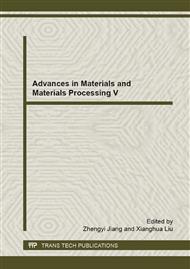p.902
p.906
p.911
p.915
p.922
p.927
p.934
p.938
p.942
Effect of Equal-Channel Angular Pressing Passes on Corrosion Behavior of Ultrafine-Grained Pure Iron
Abstract:
A series of bulk ultrafine-grained (UFG) pure iron with grain size of 250-450 nm were fabricated by equal-channel angular pressing (ECAP) and annealing. Effects of ECAP passes on the corrosion behavior of the UFG pure iron were investigated. Results show that ECAP accelerates the acid corrosion rate of pure iron, but improves its anodic passivation property. The acid corrosion resistance of the UFG pure iron is restored through a large number of ECAP passes as well as through an annealing treatment. Annealing treatment is not good for the anodic passivation property of the UFG pure iron after a small number of ECAP passes. However, after a large number of ECAP passes (up to16), the corrosion resistance and anodic passivation property of UFG pure iron are less affected by annealing.
Info:
Periodical:
Pages:
942-946
Citation:
Online since:
March 2015
Authors:
Price:
Сopyright:
© 2015 Trans Tech Publications Ltd. All Rights Reserved
Share:
Citation:


